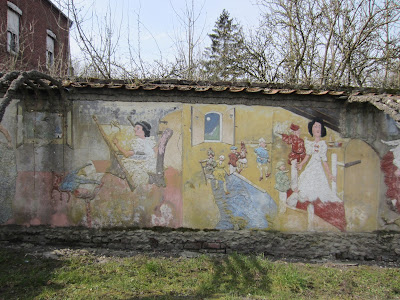For a long time this area has been dominated by the mining industry and some fifteen of the twenty creators of art environments presented in the book, were employed by a mining company.
Among the creators of art environments portrayed in the book are those who are already known in the field, such as Charles Pecqueur (1908-1991) from Ruitz, who inter alia decorated a wall in his backyard with the story of Snow White, a site currently still extant, but in decay, the frescoes gradually fading away.
In addition to the presentation in the inventory section of the book, the introductory section has a separate essay about habitants-paysagistes and about Pecqueur written by Bernard Lassus, author of Jardins imaginaires Les habitants-paysagistes (1977).
 |
| picture (2013) courtesy of Rita and Pieter van den Boogaart |
Also somewhat known is René Pecqueur (1933-2003) who lived in Louches and who embellished the outdoor space of his house with tree-like structures with brightly colored scenes, a site that was demolished after he died,
This self-taught artist also has a separate essay in the introductory part of the book, contributed by Michel Cabal.
 |
| picture courtesy of Marguerite Tartart |
The sculpture garden of Léon Evangelaire (b 1925) from Pont-à-Vendin, which is portrayed on the cover of the book, is also known in the field of art environments. It is kind of a small zoo featuring Tarzan and Jane.
 |
| picture courtesy of Thierry Bariolle |
Another well known site presented in this book is the one by Rémy Callot (1926-2001), who created mosaics on the inside of the fences surrounding his home in Carvin, creations that were discovered only when his house for traffic reasons had to be demolished in 2006, which however partly was stopped in time.
In the introductory section of the book, the story of the discovery is related by Tiphaine Kempka.
 |
| picture courtesy of Sophie Lepetit |
Two more art environments are presented in this book which are familiar to those interested in the field. First the castlelike house realized in Berck-sur-Mer by Joseph Meyer (1914-?), currently still existing.
 |
picture courtesy of Rita and Pieter van den Boogaart |
And finally, the Ferme aux avions by Arthur Vanabelle (1922-2014), a site much discussed recently, which after the death of its creator was sold to a private party, whereby it remains to be seen what happens with the various decorative constructions.
 |
picture courtesy A van der Weerd |
But then, the inventory section of the book has some twelve art environments made by people whose names are rather unknown in today's field of art environments, some because they wish to remain anonymous, while others might have been mentioned in old publications but are passed by in today's digital forms of publicity.
Sites already reviewed in this weblog when this article was fist published (2015) are: Jean Cathelain (1932-2011) with his -currently no more existing- small sculpture garden in Billy-Montigny, Philippe Hermez (b. 1964) with his monde fantastique in Meurchin and Jean Poteau (1947-2010) with his -now demolished- havre du pêcheur in Rouvroy.
Sites added to this blog in later years are: Alain Lefranc (1951-2022) who decorated his garden, which became overgrown after he died, Alfred Flament (born 1947) who decorated his currently stll existing house and garden, Concetta and Michele Sassano (both born in the mid 1930s) who during some fifty years decorated their house and garden, a site that currently doesn't exist anymore and Henri Lhotellery (born 1931) whose in 2023 still existing garden has a mixture of technical and artistic creations.
This is an interesting and informative publication. For all I know it is the first time that a number of art environments is presented in the context of the social and cultural characteristics of a particular region. And, especially now that the mining area in northern France in 2012 was added to UNESCO's world heritage list, it is an excellent initiative to highlight the cultural contribution made by self-taught artists, and capture in pictures and texts their vulnerable creations that seldom can withstand the test of time
Le Service du Patrimoine Culturel de la région Nord-Pas de Calais, D'Étonnants Jardins en Nord-Pas de Calais. Inventaire général du patrimoine culturel (Images du Patrimoine, 293). Lyon (Ed. Lieux-Dits), 2015. ill. -144 p
first published December 2015, updated September 2023

Уважаемый Хенк Спасибо!
ReplyDeleteThank you, Alexander
ReplyDelete